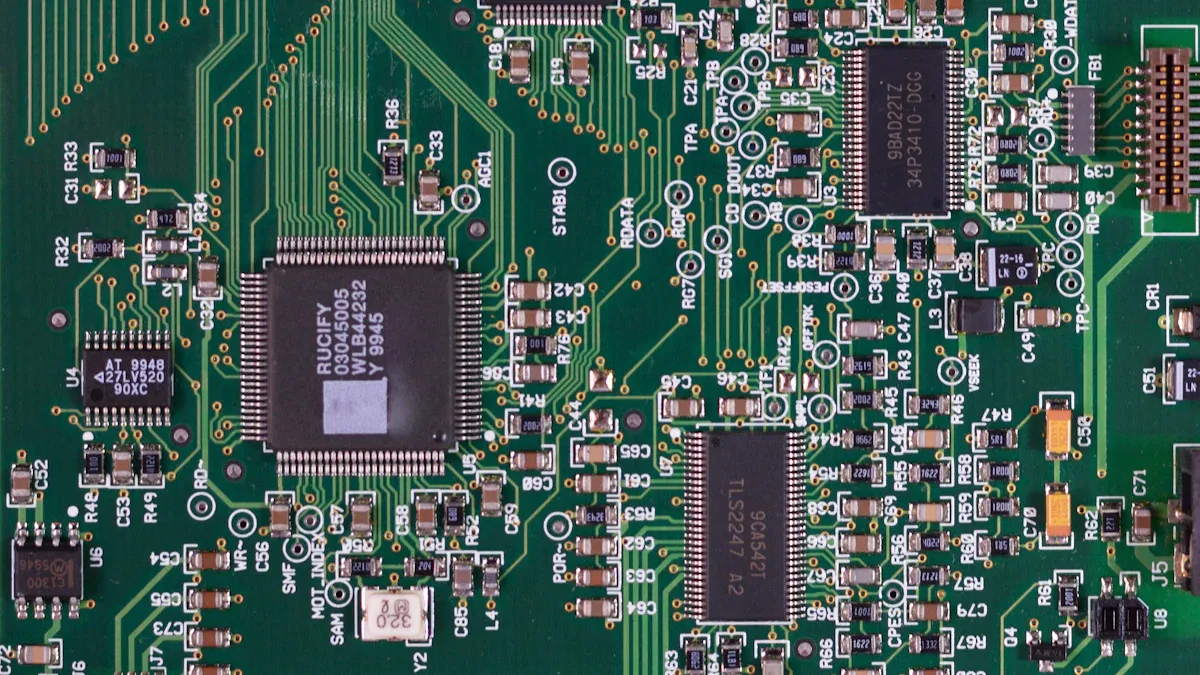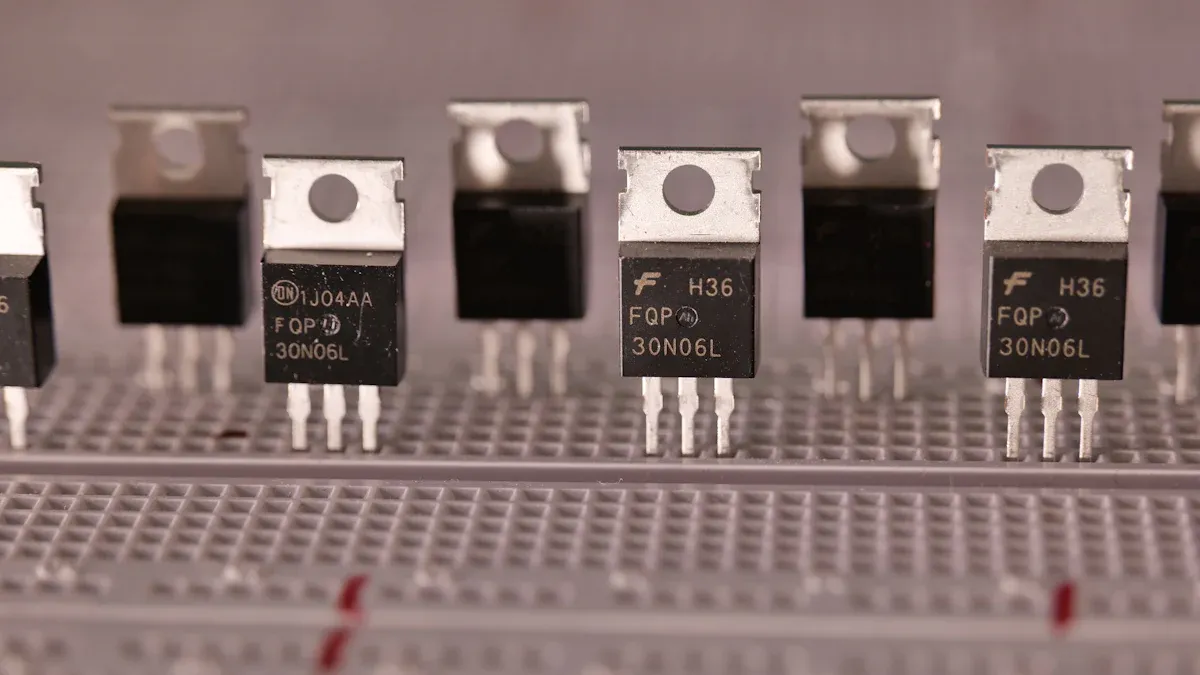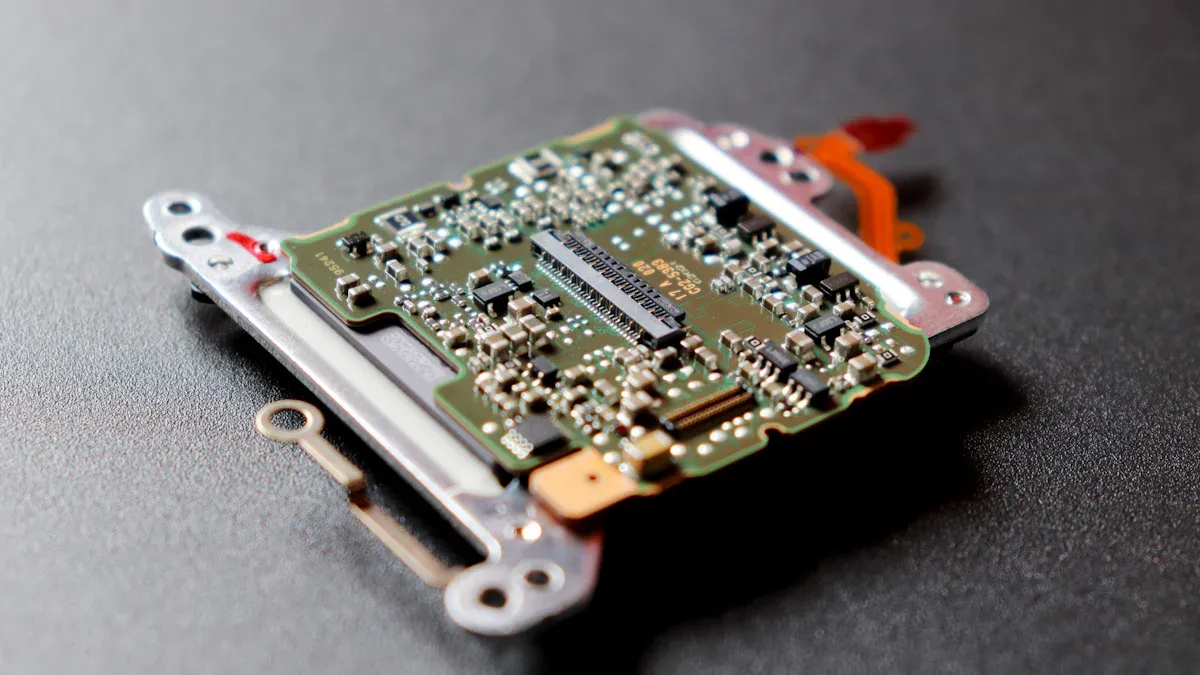What Are Low-Power Operational Amplifier ICs

Low-power operational amplifier ICs are specialized electronic components designed to perform amplification tasks while consuming minimal energy. They play a crucial role in devices where battery life matters most. For example, the MAX41400 reduces current consumption tenfold in shutdown mode compared to continuous operation. Similarly, the TSU11 series operates at just 900 nA, showcasing ultra-low power usage. These ICs are essential for energy-efficient systems like IoT devices and portable medical electronics, which rely on their precision and efficiency to function reliably over extended periods.
Key Takeaways
Low-power op-amps boost signals while using very little energy.
They help batteries last longer by using tiny resting current.
This is important for small gadgets like wearables and IoT devices.
Their small size fits into tight spaces without losing performance.
These op-amps work well in energy-saving tools like medical gear.
Picking the right one means balancing power use and performance.
Understanding Low-Power Operational Amplifier ICs
Definition and basic functionality
A low-power operational amplifier IC is a type of integrated circuit designed to amplify electrical signals while consuming minimal energy. These ICs are essential for devices that prioritize energy efficiency, such as battery-powered gadgets and portable electronics. They operate by taking weak input signals, amplifying them, and producing stronger output signals. This process ensures that even the smallest signals can be processed effectively in your devices.
One of the key characteristics of these amplifiers is their ability to extend battery life. By consuming less power, they reduce the need for frequent recharging or battery replacement. Additionally, they generate less heat, which improves the reliability of your device and allows for more compact designs. This makes them ideal for applications like wearables, smartphones, and medical devices.
Low-power operational amplifier ICs also feature high input impedance. This minimizes the load on the signal source, ensuring accurate signal processing. Input impedance depends on factors like input DC resistance and input capacitance, which are carefully optimized in these ICs to maintain performance.
Key differences from standard operational amplifiers
Low-power operational amplifier ICs differ significantly from standard operational amplifiers in several ways. The most notable difference is their focus on energy efficiency. While standard amplifiers prioritize high performance and speed, low-power versions are designed to consume as little energy as possible. This makes them better suited for energy-sensitive applications.
Another key difference lies in their power consumption metrics. Low-power operational amplifier ICs use less quiescent current, which is the current consumed when the amplifier is idle. This feature is crucial for devices that need to remain operational for long periods without draining the battery. In contrast, standard amplifiers often consume more power, making them less suitable for portable or battery-powered systems.
The growing demand for low-power operational amplifier ICs is also driven by industry trends. For example, the rise of IoT devices and AI applications has increased the need for efficient signal processing. These amplifiers play a critical role in managing power consumption in such technologies. Similarly, the automotive industry relies on them for energy-efficient systems in electric vehicles (EVs) and advanced driver-assistance systems (ADAS). The table below highlights some of these trends:
Impact on Demand for Low-Power Op-Amps | |
|---|---|
Increased Demand for Power Efficiency | Drives popularity of power op-amps for better energy management |
Growing Applications in AI & IoT | Integral role in signal processing for these technologies |
Rising Demand for Automotive Electronics | Need for efficient amplifiers in EVs and ADAS |
Increasing Industrial Automation | Demand for reliable op-amps in robotics and automated systems |
Key Features of Low-Power Operational Amplifier ICs
Low quiescent current and power consumption
Low quiescent current is one of the defining traits of a low-power operational amplifier IC. Quiescent current refers to the small amount of current the amplifier consumes when idle. By minimizing this current, these ICs help you conserve energy in your devices. This feature is especially important for battery-powered systems, where every milliamp-hour counts. For example, in wearables or IoT sensors, low quiescent current ensures longer operation without frequent recharging. You can rely on these amplifiers to keep your devices running efficiently, even in standby mode.
High efficiency and precision
Efficiency and precision go hand in hand with low-power operational amplifier ICs. These amplifiers are designed to deliver accurate signal processing while using minimal energy. High efficiency means less wasted power, which translates to better performance in energy-sensitive applications. Precision ensures that the amplified signals remain true to their original form, avoiding distortion. This makes these ICs ideal for applications like medical devices, where accurate signal interpretation is critical. You can trust these amplifiers to provide reliable performance in scenarios where both accuracy and energy savings are essential.
Compact design for space-constrained applications
The compact design of low-power operational amplifier ICs makes them perfect for modern, space-constrained devices. As technology advances, devices like smartphones, hearing aids, and IoT modules are becoming smaller. These amplifiers are engineered to fit into tight spaces without compromising functionality. Their small size also allows you to integrate them into multi-functional systems, saving valuable board space. Whether you're designing a portable gadget or a complex industrial system, these ICs offer the flexibility you need to optimize your design.
Compatibility with low-supply-voltage systems.
Low-power operational amplifier ICs excel in systems that operate on low supply voltages. These amplifiers are designed to function reliably even when powered by minimal voltage levels, making them ideal for battery-powered devices and energy-sensitive applications. You can use them in devices that rely on rechargeable cells or compact power sources, ensuring consistent performance without compromising efficiency.
One example of this compatibility is the TLV272C operational amplifier. It operates at a minimum supply voltage of 2.7V, which suits low-supply-voltage systems perfectly. Its rail-to-rail output swing maximizes the output range, allowing you to achieve optimal signal amplification even in constrained power environments. The TLV272C supports supply voltages ranging from ±1.35V to 16V, making it versatile for various applications. Whether you're working with 5V systems or rechargeable batteries, this amplifier adapts to your needs.
These amplifiers also consume minimal current, which is crucial for low-power applications. The TLV272C, for instance, delivers a bandwidth of 2 MHz while using only 550μA of supply current. This efficiency ensures that your devices remain operational for extended periods without draining the battery. Additionally, the CMOS inputs provide high impedance, making these amplifiers suitable for sensor interfaces in battery-powered systems.
When designing low-supply-voltage systems, you need components that balance performance and energy efficiency. Low-power operational amplifier ICs meet this requirement by offering reliable operation, minimal power consumption, and compatibility with a wide range of voltage levels. Their ability to function in low-voltage environments makes them indispensable for modern electronics, from IoT devices to medical equipment.
Applications of Low-Power Operational Amplifier ICs

Portable devices like smartphones and wearables
Low-power operational amplifier ICs are indispensable in portable devices, where energy efficiency and compactness are critical. You’ll find these amplifiers in smartphones, wearables, and other battery-powered gadgets. They help extend battery life by consuming minimal power while maintaining high performance. For instance, in wearables like fitness trackers and smartwatches, these amplifiers process sensor data efficiently, ensuring accurate readings without draining the battery.
The growing demand for portable electronics has made these amplifiers a cornerstone of modern technology. Consumers expect longer battery life and enhanced functionality in smaller devices. Low-power operational amplifiers meet these expectations by enabling efficient signal processing and amplification. They also contribute to better audio quality in smartphones and tablets, enhancing your overall user experience.
Key Market Insights:
The rise of wearable technology and portable medical devices has driven the demand for low-power operational amplifiers.
These amplifiers play a crucial role in extending battery life and improving performance in portable electronics.
Their applications include audio enhancement, signal conditioning, and efficient power management.
IoT systems and sensor interfaces
In IoT systems, low-power operational amplifier ICs are vital for managing power consumption and ensuring reliable performance. These amplifiers process signals from sensors, enabling devices to communicate effectively within a network. For example, in wireless sensor networks, they amplify weak signals while consuming minimal energy, which is essential for maintaining long battery life in remote or hard-to-reach locations.
A study on wake-up receiver architectures highlights the importance of these amplifiers in IoT applications. It shows how low-power designs enhance sensitivity and power efficiency, achieving a detection probability of 90% over a distance of 34 meters. This level of performance ensures that your IoT devices remain responsive and efficient, even in challenging environments.
You’ll also see these amplifiers in smart home systems, where they enable devices like thermostats and security cameras to operate seamlessly. By reducing power consumption, they help you create energy-efficient solutions for your home or business.
Medical equipment such as ECG monitors and hearing aids
Low-power operational amplifier ICs are a game-changer in medical technology. They provide the precision and efficiency needed for devices like ECG monitors, hearing aids, and portable diagnostic tools. In ECG monitors, these amplifiers process tiny electrical signals from the heart, ensuring accurate readings that doctors can rely on. Their low power consumption allows these devices to operate for extended periods, which is crucial in medical emergencies or remote monitoring scenarios.
In hearing aids, these amplifiers enhance sound quality while minimizing energy use. This ensures that users can enjoy clear audio without frequent battery replacements. The compact design of these amplifiers also allows manufacturers to create smaller, more comfortable devices for patients.
Performance Highlights:
Specification
Requirement
Theory
Schematic
Layout
ISS
10 μA
10 μA
9.72 μA
9.72 μA
Av0
>90 dB
134.3 dB
91.84 dB
91.72 dB
GB
>30 MH
40 M
50.87 M
46.1 M
Pdiss
<1 mW
0.403 mW
0.675 mW
0.661 mW
These amplifiers not only meet stringent medical requirements but also pave the way for innovative healthcare solutions. Whether you’re designing a portable ECG monitor or a next-generation hearing aid, low-power operational amplifiers provide the reliability and efficiency you need.
Industrial and automotive systems.
Low-power operational amplifier ICs play a vital role in industrial and automotive systems. These amplifiers help you achieve energy efficiency and reliable performance in applications like factory automation, robotics, and electric vehicles (EVs). Their low power consumption ensures that systems operate smoothly without excessive energy use, which is critical for reducing operational costs and environmental impact.
In industrial settings, these amplifiers are used in sensor interfaces to monitor temperature, pressure, and other parameters. They amplify weak signals from sensors, allowing you to process data accurately. For example, in automated manufacturing systems, these amplifiers ensure precise control of machinery by maintaining signal integrity. Their compact design also makes them ideal for space-constrained environments, such as robotic arms and compact control units.
In automotive systems, low-power operational amplifiers are essential for advanced driver-assistance systems (ADAS) and EV battery management. ADAS relies on these amplifiers to process signals from cameras, radar, and ultrasonic sensors. This enables features like lane-keeping assistance and collision avoidance. In EVs, these amplifiers help monitor battery voltage and current, ensuring efficient energy management and extending battery life.
You can also use these amplifiers in infotainment systems to enhance audio quality. Their high efficiency and precision ensure clear sound reproduction, improving the driving experience. Whether you're designing industrial automation equipment or automotive electronics, low-power operational amplifiers provide the reliability and efficiency you need.
Use in ADCs, DACs, and signal processing circuits.
Low-power operational amplifier ICs are indispensable in analog-to-digital converters (ADCs), digital-to-analog converters (DACs), and signal processing circuits. These amplifiers ensure accurate signal conversion and processing, which is crucial for applications like audio systems, medical devices, and communication equipment.
In ADCs, these amplifiers buffer input signals to prevent loading on the source. High input impedance ensures that signals remain intact during conversion. Adequate bandwidth allows you to reproduce input signal frequencies accurately, while low noise maintains signal quality. Stability is another critical factor, as it prevents oscillations that could distort output signals. The table below highlights key performance factors for these applications:
Performance Factor | Description |
|---|---|
Input Impedance | High input impedance is crucial to prevent loading on the source, ensuring signal integrity. |
Bandwidth | Adequate bandwidth is necessary to accurately reproduce input signal frequencies. |
Noise | Low-noise buffers are essential to maintain signal quality and integrity. |
Stability | Stability is vital to avoid oscillations that can distort output signals. |
Power Consumption | Low-power buffers are important in battery-powered applications to conserve energy. |
In DACs, low-power operational amplifiers help you convert digital signals into analog outputs with high precision. This is essential for applications like audio playback, where signal accuracy directly impacts sound quality. These amplifiers also support signal conditioning, ensuring that output signals meet the required specifications.
Signal processing circuits benefit from the efficiency and precision of these amplifiers. Whether you're filtering, amplifying, or modulating signals, low-power operational amplifiers provide the performance you need without draining your power source. Their compact design and compatibility with low-supply-voltage systems make them ideal for portable and battery-powered devices.
By integrating low-power operational amplifier ICs into your ADCs, DACs, and signal processing circuits, you can achieve reliable performance and energy efficiency. These amplifiers are a cornerstone of modern electronics, enabling you to create innovative solutions for a wide range of applications.
Comparison with Standard Operational Amplifiers

Differences in power consumption and efficiency
Low-power operational amplifier ICs excel in energy efficiency compared to standard operational amplifiers. You’ll notice that these amplifiers consume significantly less quiescent current, which is the idle current drawn when the device isn’t actively amplifying signals. This feature makes them ideal for applications where conserving energy is critical, such as battery-powered devices. Standard amplifiers, on the other hand, often prioritize performance metrics like speed and bandwidth, which can lead to higher power consumption.
For example, if you’re designing a wearable device, a low-power operational amplifier IC ensures longer battery life without sacrificing signal quality. Standard amplifiers might deliver faster processing but would drain the battery more quickly. Choosing the right amplifier depends on your application’s energy requirements and operational priorities.
Performance trade-offs in specific applications
When comparing low-power operational amplifiers to standard ones, you’ll encounter trade-offs in performance. Low-power amplifiers focus on minimizing energy use, which sometimes limits their speed or bandwidth. For instance, in high-frequency applications like RF systems, standard amplifiers might outperform low-power versions due to their ability to handle faster signal processing.
However, low-power amplifiers shine in applications where precision and energy efficiency matter most. In medical devices like ECG monitors, these amplifiers process small signals accurately while consuming minimal power. Standard amplifiers might offer higher gain or faster response times, but they often compromise energy efficiency. Understanding these trade-offs helps you select the right amplifier for your specific needs.
Advantages in energy-sensitive use cases
Low-power operational amplifier ICs offer unmatched benefits in energy-sensitive applications. You’ll find them indispensable in devices like IoT sensors, portable medical equipment, and automotive systems. Their ability to operate on low supply voltages and consume minimal power makes them perfect for scenarios where energy conservation is a priority.
For example, in IoT systems, these amplifiers ensure long battery life for remote sensors, reducing maintenance costs and downtime. In electric vehicles, they help manage battery systems efficiently, extending the vehicle’s range. Standard amplifiers might deliver higher performance in some cases, but they lack the energy-saving capabilities that low-power amplifiers provide. If your project demands reliability and efficiency in energy-sensitive environments, low-power operational amplifiers are the clear choice.
Low-power operational amplifier ICs redefine energy efficiency in modern electronics. These amplifiers amplify signals while consuming minimal power, making them essential for portable devices, IoT systems, and medical equipment. Their compact design and compatibility with low-supply-voltage systems enable innovative solutions in space-constrained applications.
The demand for these amplifiers continues to rise due to advancements in efficiency and miniaturization. Key trends include a projected market growth of 7% CAGR through 2030 and the dominance of low-power devices, which accounted for 60% of the market in 2023. Industries like automotive and consumer electronics increasingly rely on these amplifiers to enhance energy conservation and functionality.
You can leverage low-power operational amplifier ICs to create energy-efficient designs that align with sustainability goals. Their versatility and reliability make them a cornerstone of modern technology. Explore their potential to elevate your projects and contribute to a greener future.
FAQ
1. What is the main advantage of using low-power operational amplifier ICs?
Low-power operational amplifiers help you save energy by consuming minimal power. This extends battery life in portable devices and reduces energy costs in larger systems. Their efficiency makes them ideal for energy-sensitive applications like IoT devices, medical equipment, and automotive systems.
2. Can low-power operational amplifiers handle high-speed applications?
Low-power operational amplifiers prioritize energy efficiency over speed. They may not perform as well as standard amplifiers in high-speed applications like RF systems. However, they excel in low-frequency, precision-focused tasks where conserving energy is more important than processing speed.
3. Are low-power operational amplifiers suitable for all battery-powered devices?
Yes, they work well in most battery-powered devices. Their low quiescent current and compatibility with low-supply-voltage systems make them perfect for wearables, IoT sensors, and medical devices. However, you should evaluate your device's specific performance needs before choosing one.
4. How do low-power operational amplifiers improve IoT systems?
These amplifiers process sensor signals efficiently while consuming minimal energy. This ensures long battery life for IoT devices, even in remote locations. Their precision and reliability also enhance the performance of smart home systems, wireless networks, and industrial IoT applications.
5. What should you consider when selecting a low-power operational amplifier?
Focus on factors like quiescent current, supply voltage range, input impedance, and bandwidth. Match these specifications to your application’s requirements. For example, a wearable device might need ultra-low power consumption, while a medical device might prioritize precision and stability.
See Also
Diving Into Innovative Capabilities of Low Power Switcher ICs
Grasping Low Power IoT Chip Tech and Its Uses
Defining Step-Down Converter Integrated Circuits and Their Function
Explaining the Functionality of Low Impedance Switch Chips
Exploring the Benefits of High-Performance Microcontroller ICs
